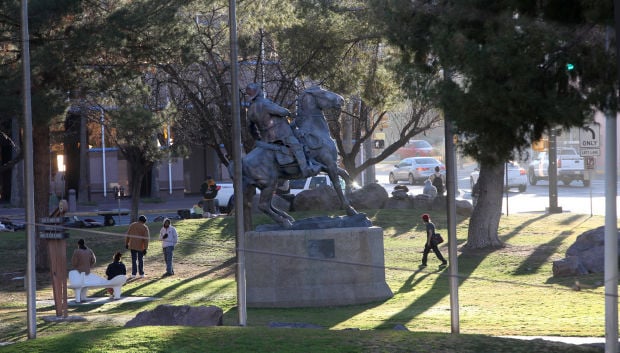The city has taken its first steps in complying with a federal judge’s court order regarding a downtown homeless camp.
On Tuesday, city workers repainted a black line on the sidewalk along the west side of Church Avenue between Congress Street and Broadway to mark where the homeless can sleep after Veinte de Agosto Park closes at night.
Last week, U.S. District Court Judge David Bury granted the organizers of the downtown homeless camp an injunction preventing police from arresting homeless people for possessing more than three items.
Bury also said the city had to clearly identify park boundaries and hours since police and the homeless often clash over where people can legally sleep on the sidewalk after the park closes.
“The purpose of the painted line is to give clear and certain notice to all persons of the park boundary, because the park closes from sunset to dawn,” City Attorney Mike Rankin wrote in a memo.
Rankin said the city would post additional signage noting the parks hours to comply with the Bury’s orders.
The injunction stems from an ongoing lawsuit filed against the city by activists John Cooper and Jon McLane.
The pair claimed the city mistreated people who attempted to camp in Tucson parks and sleep on city sidewalks. Activists set up the camp in October 2013 to provide the homeless who fall through the shelter- systems cracks a safe place to sleep. The camp doubled as a protest against government failure to help the homeless and to correct other social ills.
When police attempted to roust folks from sleeping in the park as last year’s gem show approached, McLane and Cooper argued the city was violating a person’s First Amendment right to protest homelessness.
Last January, the city assumed the homeless at the park were protesting and allowed them to continue sleeping on the sidewalk as long as they kept no more than a blanket, a bedroll and a beverage and left at least five feet of sidewalk for pedestrians to pass.
Even with rules in place, police and the homeless still jostled over boundary lines and what counted as excessive possessions.
Councilman Steve Kozachik said the city could have avoided these conflicts had it approached the issue as a homeless problem and not a free- speech problem.
“This isn’t a matter of free speech, but we back ourselves into a corner by allowing that to be a part of the narrative,” said Kozachik, whose ward includes the park. “The guts of this issue is homelessness and how we’re going to address it as a community. We should be working with nonprofits and the faith-based community to address homelessness, not passing ordinances that permit people to sleep on sidewalks. That does nothing for anybody.”
McLane said he has discussed options to set up a more permanent camp within a three-mile radius of downtown and other plans with Kozachik and other city officials.
“That dialogue has been going on for a while,” McLane said. “But it seems like every single plan we come to them with is insufficient.”
McLane said he’s not waiting for the city to act and plans on moving forward with his vision for the park, which includes adding storage compartments, tables and canopies.
“Stuff along those lines to make it a 24-hour, one-stop spot for services or practicing First Amendment activity,” McLane said.





